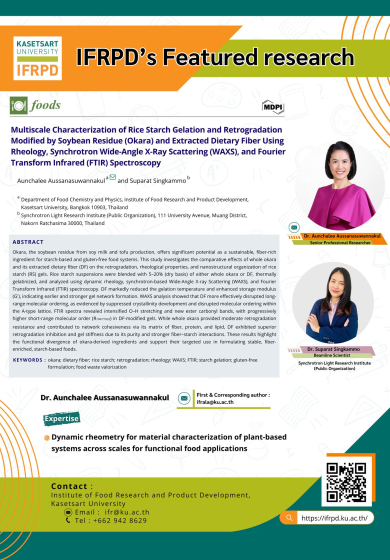Multiscale Characterization of Rice Starch Gelation and Retrogradation Modified by Soybean Residue (Okara) and Extracted Dietary Fiber Using Rheology, Synchrotron Wide-Angle X-Ray Scattering (WAXS), and Fourier Transform Infrared (FTIR) Spectroscopy
| ผลงานวิจัย |
ดร.อัญชลี อุษณาสุวรรณกุล และคณะ |
| Keywords |
okara; dietary fiber; rice starch; retrogradation; rheology; WAXS; FTIR; starch gelation; gluten-free formulation; food waste valorization |
| Telephone |
0 2942 8629 (1506) |
| Email |
ifrala@ku.ac.th |
| URL |
https://doi.org/10.3390/foods14111862
|
จุดเด่นผลงาน
งานวิจัยนี้ศึกษาผลของโอคาราและใยอาหารสกัดต่อการเกิดเจล การคืนตัว และโครงสร้างระดับนาโนของเจลแป้งข้าวเจ้า ผลการประเมินพบว่า ใยอาหารโอคาราช่วยลดการตกผลึก เสริมโครงสร้างเจล และเพิ่มความคงตัว ชี้ให้เห็นศักยภาพในการใช้ในผลิตภัณฑ์ปลอดกลูเตนที่มีใยอาหารสูงอย่างยั่งยืน
Abstract : Okara, the soybean residue from soy milk and tofu production, offers significant potential as a sustainable, fiber-rich ingredient for starch-based and gluten-free food systems. This study investigates the comparative effects of whole okara and its extracted dietary fiber (DF) on the retrogradation, rheological properties, and nanostructural organization of rice starch (RS) gels. Rice starch suspensions were blended with 5–20% (dry basis) of either whole okara or DF, thermally gelatinized, and analyzed using dynamic rheology, synchrotron-based Wide-Angle X-ray Scattering (WAXS), and Fourier Transform Infrared (FTIR) spectroscopy. DF markedly reduced the gelation temperature and enhanced storage modulus (G′), indicating earlier and stronger gel network formation. WAXS analysis showed that DF more effectively disrupted long-range molecular ordering, as evidenced by suppressed crystallinity development and disrupted molecular ordering within the A-type lattice. FTIR spectra revealed intensified O–H stretching and new ester carbonyl bands, with progressively higher short-range molecular order (R1047/1022) in DF-modified gels. While whole okara provided moderate retrogradation resistance and contributed to network cohesiveness via its matrix of fiber, protein, and lipid, DF exhibited superior retrogradation inhibition and gel stiffness due to its purity and stronger fiber–starch interactions. These results highlight the functional divergence of okara-derived ingredients and support their targeted use in formulating stable, fiber-enriched, starch-based foods.
Foods 2025, 14(11), 1862





